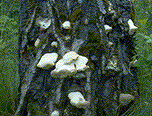Archived Content
Information identified as archived on the Web is for reference, research or recordkeeping purposes. It has not been altered or updated after the date of archiving. Web pages that are archived on the Web are not subject to the Government of Canada Web Standards. As per the Communications Policy of the Government of Canada, you can request alternate formats on the Contact Us page.
Brown Stringy Trunk Rot of Hardwoods
Spongipellis delectans (Peck) Murrill
(=Polyporus delectans Peck)
Basidiomycotina, Aphyllophorales, Polyporaceae
Hosts:Spongipellis delectans is an important decay of black cottonwood, and has only been found on this species in B.C. In other parts of North America it has been reported on maple, alder, and oak.
Distribution: This fungus is most likely found wherever cottonwood is present but has been poorly collected to date.
Identification: The fruiting bodies are annual, fleshy to leathery, up to 7 cm deep x 15 cm wide x 4.5 cm high, and of various shapes, but usually shelved (Fig. 25a). The upper and lower surfaces and the context are white when fresh, drying to light brown. The lower surface is poroid, the pores are small and regular in outline.
The decay first becomes apparent as buff to light brown streaks in the heartwood. In the advanced stage of the decay, the wood becomes light in weight, uniformly dark brown, usually stringy but sometimes laminate. Initially the decay will form pockets of various sizes but in time these usually come together to form a column.
Microscopic Characteristics: Hyphae in the context of the fruiting body hyaline, thin and thick-walled, with clamp connections. Basidiospores broadly ellipsoid to subglobose, hyaline, smooth, IKI-, 7-9 x 5-7 µm. Growth in culture moderate, mat white, laccase positive. Stalpers: 1 3 (6) (7) (8) (11) (12) (13) (14) 21 22 30 (39) 40 42 (44) (45) (50) 52 (54) (58) (60) (61) (78) 80 (82) 83 84 85 (88) 89 (94) (95) (96) 97 100.
Damage: Significant losses in wood strength occur in trees with advanced decay.
Remarks: Decay occurs mainly as a trunk rot, rarely as a butt rot, in both living and dead trees. In living trees, decay is usually confined to the heartwood. Infection appears to occur through branch stubs or branch scars.
References:
Gilbertson, R. L. and L. Ryvarden. 1987. North American Polypores. 2:723. Fungiflora, Oslo.
Thomas, G. P. and D. G. Podmore. 1953. Decay in Black Cottonwood in the middle Fraser region, British Columbia. Can. J. Bot. 31: 675-692.
Figures
Click on any image to see the full size version.
Press "Back" on your browser to return to this screen.

Figure 25a: Fruiting bodies of S. delectans on a cottonwood stump.
 This Web page has been archived on the Web.
This Web page has been archived on the Web.